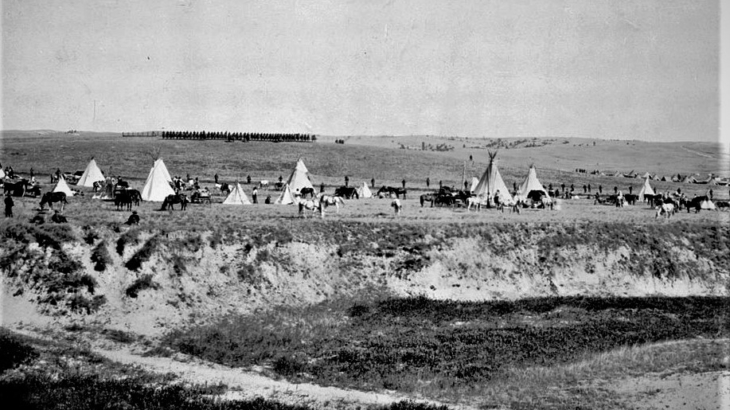December 29, 1890: The Wounded Knee Massacre, Also Known as the Battle of Wounded Knee
The Massacre at Wounded Knee, part of the Ghost Dance War, marked the last of the Indian Wars and the end of one of the bloodiest eras in American History, the systematic and deliberate slaughter of Native American peoples and their way of life. It was an American Holocaust. During a 500 year period, approximately 100,000,000 Native Americans were killed as citizens of the United States pushed West in the name of manifest destiny and destroyed the Native American territories that had been their home for thousands of years. These events will never take a place on the front of our history books, but they must never lose their place in our national memory.
Armed conflict was still prevalent in the American West in the 1880s between the U.S. Army and the Native American population, even after most of the tribes there had been displaced or had their populations reduced in great numbers. The Battle of Little Bighorn in 1876 had been the most fierce of the wars with the Sioux, which had started in the mid-1850s, when Chiefs Sitting Bull and Crazy Horse had gone to war to defend the Black Hills after the U.S. violated the treaty that they had signed stating the land was the property of the Sioux. After the Battle of Little Bighorn, a gradual depletion of Sioux forces occurred and Crazy Horse surrendered in 1877.
The remaining Sioux were spread out in their reservations and eventually were placed onto a central reservation in the Dakota territory and were practicing a ritual known as the Ghost Dance. The dance was supposed to drive the white men from Native American territory and restore peace and tranquility to the region. Settlers were frightened by the dance and they said it had a “ghostly aura” to it, thus giving it its name.
In response to the settlers’ fears, U.S. commanders arrested several leaders of the Sioux, including Chief Kicking Bear and Chief Sitting Bull, who was later killed.
Two weeks after Sitting Bull’s death, U.S. troops demanded that all the Sioux immediately turn over their weapons. As they were peacefully doing so, one deaf Sioux warrior did not understand the command to turn over his rifle. As his rifle was being taken from him, a shot went off in the crowd. The soldiers panicked and open fired on everyone in the area.
As the smoke cleared, 300 dead Lakota and 25 dead U.S. soldiers were laying on the ground. Many more Lakota were later killed by U.S. troops as they fled the reservation. The massacre ended the Ghost Dance movement and was the last of the Indian Wars. Twenty U.S. soldiers were later awarded the Congressional Medal of Honor for their actions during this campaign. The National Congress of American Indians has called on the U.S. government to rescind some or all of these medals, but they have not yet taken action to do so.
The American public’s reaction to the massacre was positive at first but over time as the scale and gravity of the massacre was revealed, the American people began to understand the brutal injustice that occurred during this encounter. Today, we need to remember the Massacre at Wounded Knee for the human cost and to make sure that events like this never happen again in our nation. We also need to make sure to honor and remember all Americans and their histories, even when it is not easy to read or take responsibility. For how can we truly be a nation where all are created equal if the treatment of our histories are not?
Val Crofts is a Social Studies teacher from Janesville, Wisconsin. He teaches as Milton High School in Milton, Wisconsin, and has been there 16 years. He teaches AP U.S. Government and Politics, U.S. History and U.S. Military History. Val has also taught for the Wisconsin Virtual School for seven years, teaching several Social Studies courses for them. Val is also a member of the U.S. Semiquincentennial Commission celebrating the 250th Anniversary of the Declaration of Independence.
Click Here to have the NEWEST essay in this study emailed to your inbox every day!
Click Here to view the schedule of topics in our 90-Day Study on American History.




Join the discussion! Post your comments below.
Your feedback and insights are welcome.Feel free to contribute!